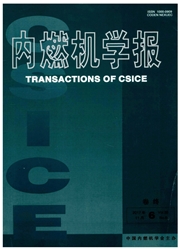

 中文摘要:
中文摘要:
利用气相色谱技术,对醇类燃料发动机主要非常规排放物的分析方法进行了研究。通过对色谱柱的种类、柱温和载气流速的优化,以及对保留时间的理论预测,得到了甲醛、乙醛、甲醇、乙醇、1,3-丁二烯、苯等非常规排放物的最佳色谱分离条件。此外,以苯为内标物,分别测量了其它5种非常规排放物的相对校正因子。同时检测了相对标准偏差(n=6)及检出限,并采用优化的测量方法进行了实际样品的测量。实验结果表明,选用惠普FFAP色谱柱作为分离色谱柱,载气流速为1.0mL/min,柱温箱温度为40℃时,上述6种非常规排放物的分离效果最好,除甲醛和乙醛外,校正因子实际测量值与文献值基本吻合,其相对标准偏差全部小于15%,检测限均可达到0.01×10^-6;采用优化的色谱分析条件可有效地分离检测醇类燃料发动机中甲醛、乙醛、苯、甲醇、乙醇、1,3-丁二烯的排放量。
 英文摘要:
英文摘要:
The analytical method of unregulated emissions from alcohol-engine exhaust was investigated using gas chromatography. The optimum separating condition for formaldehyde, acetaldehyde, methanol, ethanol, benzene and 1, 3-butadiene was obtained by a series of optimizing experiments on the type of chromatography column, column temperature and flow velocity of carrier and theoretical prediction on retention time. Meanwhile, relative standard deviation (RSD) and the detection limit were tested, and the calibration factors of those unregulated emissions were calculated. Samples from alcohol-engine exhaust emissions were analyzed under the optimum separating condition. The experimental results indicated that those unregulated emissions could be well separated with FFAP capillary column under the condition of column temperature 40 ℃ and carrier velocity 1.0 mL/min ; Except for formaldehyde and acetaldehyde, the values of calibration factor are in accordance with those of previous literatures. The RSD was less than 15%, and the detection limit reach 0.01 ×10^ -6. The analysis of the sample from the alcohol-engine exhaust emissions proved that formaldehyde, acetaldehyde, methanol, ethanol, benzene and 1, 3-butadiene could be effectively separated and measured under the optimum condition.
 同期刊论文项目
同期刊论文项目
 同项目期刊论文
同项目期刊论文
 期刊信息
期刊信息
